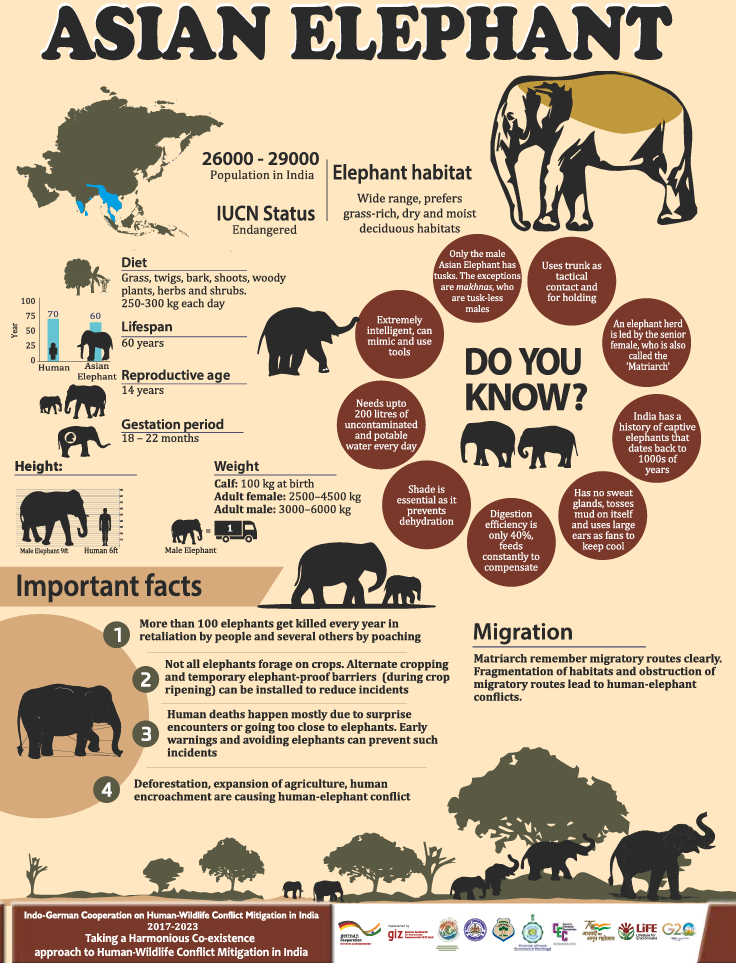Asian Elephant
Facts about Asian Elephant
 IUCN Status Endangered
IUCN Status Endangered- Population in India : 26000 - 29000
- Diet : Grass, twigs, bark, shoots, woody plants, herbs and shrubs. 250-300 kg each day
- Lifespan : 60 years
- Elephant Reproductive age : 14 years
- Gestation period : 18-22 months
- Height: 9 ft
- Weight - Calf: 100 kg at birth; Adult female: 2500-4500 kg; Adult male: 3000-6000 kg
- Elephant habitat : Wide range, prefers grass-rich, dry and moist deciduous habitats
- Interesting facts
- Extremely intelligent, can mimic and use tools
- Needs upto 200 litres of uncontaminated and potable water every day
- Shade is essential as it prevents dehydration
- Only the male Asian Elephant has tusks. The exceptions are makhnas, who are tusk-less males
- Uses trunk as tactical contact and for holding
- Digestion efficiency is only 40%, feeds constantly to compensate
- An elephant herd is led by the senior female, who is also called the 'Matriarch'
- India has a history of captive elephants that dates back to 1000s of years
- Has no sweat glands, tosses mud on itself and uses large ears as fans to keep cool
- Migration : Matriarch remember migratory routes clearly. Fragmentation of habitats and obstruction of migratory routes lead to human-elephant conflicts.
- More than 100 elephants get killed every year in retaliation by people and several others by poaching
- Not all elephants forage on crops. Alternate cropping and temporary elephant-proof barriers (during crop ripening) can be installed to reduce incidents
- Human deaths happen mostly due to surprise encounters or going too close to elephants. Early warnings and avoiding elephants can prevent such incidents
- Deforestation, expansion of agriculture, human encroachment are causing human-elephant conflict
Dos and Donts with elephants
If you encounter elephants in your area, the following are the Dos and Donts to follow.
Dos
- Slow down as soon as you see elephants. Maintain a safe distance as they may charge, if they feel threatened
- Make a loud noise using drums to drive them away if they are an immediate threat to life, property and crops
- Stop your vehicle at a distance from elephants if they are crossing a road and reverse your vehicle slowly to allow them to pass
- Be vigilant during dusk and dawn and drive slowly in areas where elephants might be present
- Use thorny bushes as fences and create trenches around farms to prevent elephants from entering farmlands
- Remove ripened fruits from trees that may attract elephants
- If elephants are present near your house and show threatening behaviour, slowly retreat inside the house and give them space to move away
- If you spot an elephant in a human use area, call the helpline numbers of the forest department
Donts
- Don't try to take a selfie or close-up photograph of an elephant or try to feed it
- Don't chase them as they may charge back at you
- Don't use high beam lights. Don't switch the engine off as you may have to reverse the vehicle and retreat if an animal charges at you
- Don't ignore warning signage that provides warnings about sensitive spots
- Don't leave your farm with standing crop unguarded
- Don't store groceries and rations outside house or in mud houses. Store grains etc. in pakka houses
- Don't open doors or come out of the house at night if elephants are present near the house
- Always keep a record of movement-information related to elephants provided by the forest department and avoid areas where elephants are present
Source : Indo-German Biodiversity Programme
Related resources
Last Modified : 8/12/2024
© C–DAC.All content appearing on the vikaspedia portal is through collaborative effort of vikaspedia and its partners.We encourage you to use and share the content in a respectful and fair manner. Please leave all source links intact and adhere to applicable copyright and intellectual property guidelines and laws.
RELATED ITEMS
Advisory for management of Human-Wildlife Conflict
National Board of Wildlife (SC-NBWL) issues adviso...
Elephant reserves in India
This topic provides information about Elephant res...
Project RE-HAB to prevent Elephant – Human Conflict Using Honey Bees
Provides information about KVIC initiative - Proje...
World Elephant Day
This page provides information about World Elephan...
